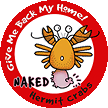
It's been exactly a week since the last day of the Naked Hermit Crab walk series ended on 7 June 2007. While this post does come a bit late in terms of its newsbreaking quality which citizen journalism is supposed to be known for, I suppose this will serve as an editorial and feature equivalent.
The last day was a particularly exciting one. As I was not guiding that day, I had the leisure, and pleasure, to wield my camera and snap to my delight. While I was happily documenting the day's event and organisms encountered, I was also the hunter/seeker for the group but honestly I think I serve my purpose on earth as a guide as I simply don't have any catching or spotting abilities. Well I did catch a juvenile damselfish, relative of the anemone clownfish, and caught 2 other fish fry and some sea lice but that's another story to be told later. But if I were ever to survive in the wild, I think my hunting skills lack sorely. Yet while hai-ren and I lament about our poor catching skills, we wonder why people with ill intent are usually so much "luckier" as sometimes we cannot even spot the organisms lurking around. I can only conclude that time, experience and the ugly lure of money make people do all kinds of things.
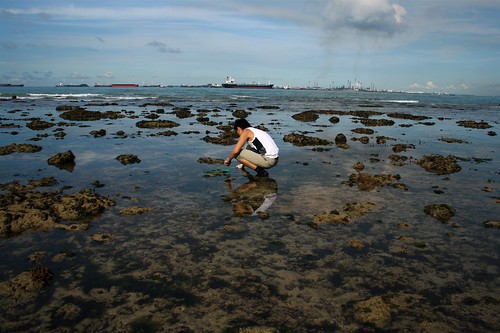
Hairen looking for fish and athropods as hunter/seeker for the day
 But before you misunderstand, the role of a hunter/seeker amongst the naked hermit crab has nothing to do with a hunter or, god forbid, a poacher. Their job is to seek out the shores for animals to bring back safely in open containers, without giving them too much stress although this is unavoidable, to show visitors on the beach without them having to trample all over the inter-tidal areas looking for them. Centralizing the animals in one area would also allow everybody to view the specimens to their own time and pace without worrying the animals will swim away. Besides, it's always hard to have every one in the group see a goby or other small animals in the water before it tries to swim or burrow away from sight. Sometimes the organisms are so tiny that it helps to bring it up to eye level.
But before you misunderstand, the role of a hunter/seeker amongst the naked hermit crab has nothing to do with a hunter or, god forbid, a poacher. Their job is to seek out the shores for animals to bring back safely in open containers, without giving them too much stress although this is unavoidable, to show visitors on the beach without them having to trample all over the inter-tidal areas looking for them. Centralizing the animals in one area would also allow everybody to view the specimens to their own time and pace without worrying the animals will swim away. Besides, it's always hard to have every one in the group see a goby or other small animals in the water before it tries to swim or burrow away from sight. Sometimes the organisms are so tiny that it helps to bring it up to eye level.

Can you spot the goby? It's not easy without some help!
Why am I talking in depth about this? Well a few days ago I thought to write about the day's events and as I was looking at the photo of hairen trawling the shores for finds, I suddenly realized that had the photo been seen out of context, it would be almost incriminating. If you, like me, feel that poaching should be strongly clamped down on, then yes, it is important to see the distinction of our roles.

Sights are marked out. See only, no touch!
However, when I saw a granny amongst our participants go down near a rock during the walk and instead of admiring the sight, started to take out a pair of prongs and knock away at the shellfish and snails to collect them in a big bag within her hands, I felt this strong urge to scream my horror. It made me reflect that had I brought my parents who often did this as a kid, how do you tell them that the shore is now a museum - see only, no touch - when decades ago, this was their market, fresh for the picking where the only cost is your labour?

Inculcating respect in kids in a wholly different way
How many children did I tell not to pick the shells where growing up, parents and kids stroll beaches for the sole purpose of "shell collecting" because it was the activity to do? How much can one or two shell hurt you ask. Well one shell collector too many seek out live animals to find the biggest and most beautiful shells to sell on the market. Shells are also homes to animals and eventually break down and become part of the coral sand, a source of sand nourishment for our constantly and naturally eroding beaches. In fact, Seacology recently published a list of "10 things to do to save our world's islands" and listed not taking shells home as one of the ways to save our beaches!

That aside, it's was a wonderful day with many photographic rewards. In fact, early in the day we spotted a dark layer of smog settling over the industrial estate of jurong island and the west of Singapore. I am happy to say that the post I wrote on the topic got me tomorrowed! In fact, Jen Lee called me the other day asking more. Those interested will be happy to know I'm digging more into the topic.
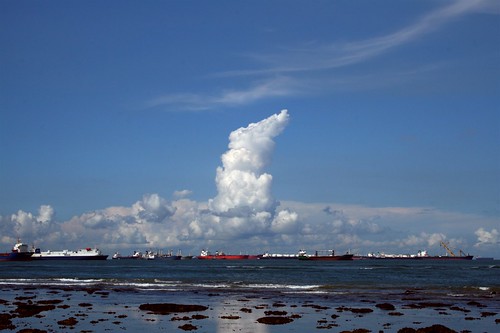
The clouds were simply spectacular that day
Despite being not very good at catching swimming crabs, it was still a day full of wildlife encounters from the regulars like the water monitor lizard we met at the seawall to the collared kingfisher that posed for me patiently. Terrestrial animals aside, we also saw eel fish, damselfish, mosaic crab, red egg crab and many a hairy crab. Of course we always meet the hermit crabs, thankfully usually shelled and clothed.

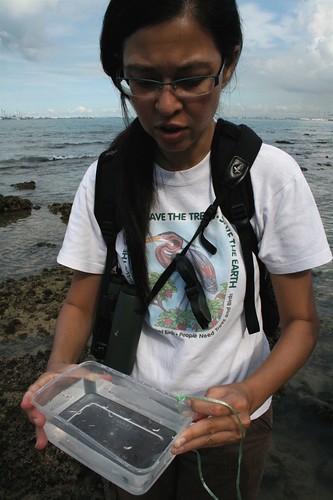

Sessile organisms were a plenty too! The usual soft corals, hard corals and everybody's spongebob multishape-pants. No sea cucumber that day but many others were encountered the previous 2 days. It was also the first time the terrestrial monkey learnt that mushroom corals can actually be picked up and removed from the water without killing it! Usually corals produce calcium carbonate that form the structure of the reef by making itself an extension of the reef. However, mushroom corals are not sessile and instead it becomes detached from its "stalk" when it matures so that others can grow from the same stalk!

Mushroom coral
We were also lucky to have Angie and Vilma from NSS, tree experts who shared with us and confirmed out suspicions as to the identity of the sea teak, a rare coastal tree seen in abundance at Sentosa! There was of course also the raffles pitcher plant with its distinct patterns. Not forgetting the variety of other plants found growing from our cliffs. What more, after much appeal from Joe Lai and other nature lovers, Resort World @ sentosa decided to save and transplant almost 200 stands of trees in its coastal forest in a last minute bid to conserve the forest and make peace with the fervent feedback and request from public. It remains unclear to the monkey if the right trees were actually saved but is it supposed to be a consolation that the trees cut down to make way for the IR would now be turned into furniture on the island?!

Pitcher plants
I did however find that some people have the misconception that if trees are found, the soil is less likely to erode. Pardon me if I am wrong but if a tree is found on a steep slope, it serves to hold loose soils together so as to prevent rainwater and runoff from washing the loose topsoil away. However, if you have trees growing on edge of cliffs or even on the cliff itself, the roots of the plant tend to grow into fractures and line of weaknesses that further loosen and widen the faultline, causing the cliff to be weakened and eventually the material will break off from the cliff. Yes, this is what we call biotic erosion agents. Some plant roots produces chemicals that react with the rocks to erode them. So it is both good for your slopes and bad for your cliffs! :)
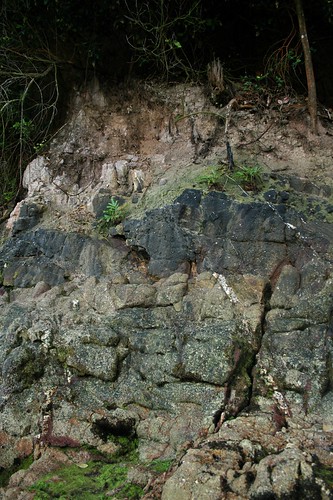
Erosion is not necessarily a bad thing though. Without erosion, we won't have the sand or soil that would eventually deposit on our slopes or shores!

Look how clear the water is! That's eroded particles and coral rubble (soon to be eroded) we are stepping on! :) But it helps that no reclamation nearby to muddy the water up but will this change soon once reclamation begins nearby?
For more photos of the day's event, see my flickr set.
If you are keen to see Naked Hermit Crabs in action on Sentosa, here's your chance:
 Date: 19 Jun 07
Date: 19 Jun 07
Time: Starts 7.30am
Duration of walk: Family Trail=1.5 hours, Adventure Trail=2.5 hours.
Cost: $5 per person (does not include Sentosa entrance fees and charges)
Exact details on meeting point will be provided to those who register for the walks.
For more information, see Adventures with the Naked Hermit Crabs.
Read full article here









 But before you misunderstand, the role of a hunter/seeker amongst the naked hermit crab has nothing to do with a hunter or, god forbid, a poacher. Their job is to seek out the shores for animals to bring back safely in open containers, without giving them too much stress although this is unavoidable, to show visitors on the beach without them having to trample all over the inter-tidal areas looking for them. Centralizing the animals in one area would also allow everybody to view the specimens to their own time and pace without worrying the animals will swim away. Besides, it's always hard to have every one in the group see a goby or other small animals in the water before it tries to swim or burrow away from sight. Sometimes the organisms are so tiny that it helps to bring it up to eye level.
But before you misunderstand, the role of a hunter/seeker amongst the naked hermit crab has nothing to do with a hunter or, god forbid, a poacher. Their job is to seek out the shores for animals to bring back safely in open containers, without giving them too much stress although this is unavoidable, to show visitors on the beach without them having to trample all over the inter-tidal areas looking for them. Centralizing the animals in one area would also allow everybody to view the specimens to their own time and pace without worrying the animals will swim away. Besides, it's always hard to have every one in the group see a goby or other small animals in the water before it tries to swim or burrow away from sight. Sometimes the organisms are so tiny that it helps to bring it up to eye level.











 Date: 19 Jun 07
Date: 19 Jun 07
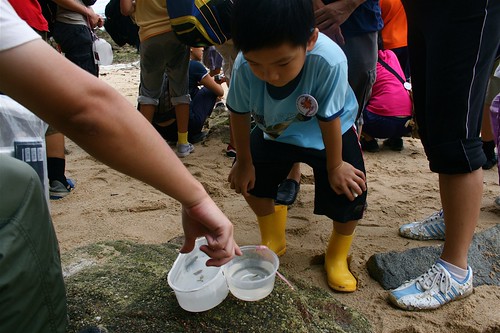


 Of course Duck, my co-guide of the day just informed me that he mistakenly identified this mosaic crab on the right as the red egg crab. Ah well, it's ok duck, you are most forgiven. I think often I learn more in a day of guiding than at any other times. It really forces one to learn on the spot and be on our toes. But I am always grateful that the participants are very forgiving creatures as if aware of the fact that we are there just as much to learn as they are. It's a sharing after all. I don't think I was ashamed to say no when one of the teenagers asked if we could cite the genera and species of corals we spotted.
Of course Duck, my co-guide of the day just informed me that he mistakenly identified this mosaic crab on the right as the red egg crab. Ah well, it's ok duck, you are most forgiven. I think often I learn more in a day of guiding than at any other times. It really forces one to learn on the spot and be on our toes. But I am always grateful that the participants are very forgiving creatures as if aware of the fact that we are there just as much to learn as they are. It's a sharing after all. I don't think I was ashamed to say no when one of the teenagers asked if we could cite the genera and species of corals we spotted.
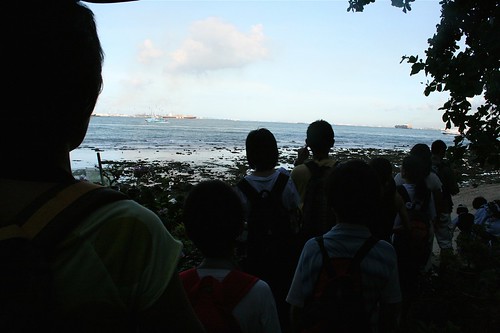


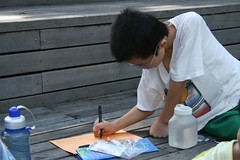

 I can be contacted at
I can be contacted at 





